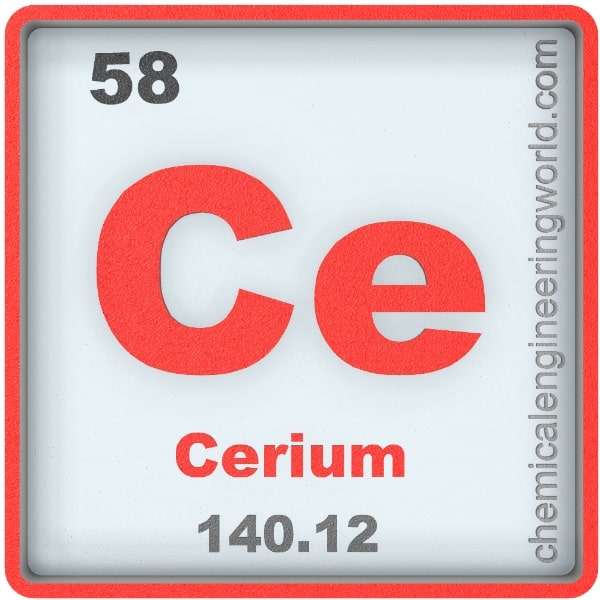Cerium Element Properties and Information

Cerium Element Properties and Information
Cerium is 58th element on the periodic table. Elements are arranged in the periodic table on the basis of the atomic number. Atomic number is the number of protons in the nucleus of the atom. Cerium has an atomic number of 58. It is located in the Group ‘Lanthanides’ and Period 6 of the periodic table of elements. It is denoted by Ce. The element is named after the asteroid ‘Ceres’.
Jöns Berzelius and Wilhelm Hisinger are credited as discoverers of cerium. Although it is one among the 14 rare earth elements, it was discovered totally independent of them simply because there are minerals available in nature which is made up exclusively of the cerium salts.
Cerium is most abundant element among all rare earth elements or lanthanoids. It makes up 66 ppm of Earth’s crust. It is more common than the common-elements thus despite being categorized as rare-earth element, cerium is not rare at all. The most common minerals of cerium are bastnaesite and monazite.
Physical Properties
- Cerium is a grey ductile metal whose hardness is similar to silver. It is 2nd lanthanide in the lanthanide series.
- The atomic mass of cerium is 140.12.
- The melting point of cerium is 799°C.
- The boiling point of cerium is 3426°C.
- The density of cerium is 6760 in S.I. units at 20°C.
- Cerium has 4 allotropic forms, among them two forms are face-centered cubic, one is body-centered cubic, and one is hexagonal close packed structure.
- Naturally occurring cerium has 4 isotopes; cerium-136, cerium-138, cerium-140, and cerium-142.
Chemical properties
- Cerium tarnishes when it is exposed to air. It continues to get corroded in presence of air. A spalling oxide layer can be seen as an observation of the ongoing corrosion.
- Cerium burns readily at 150°C forming ceria which is a term for cerium(IV) oxide.
- Grounded cerium metal is highly pyrophoric, meaning it easily catches fire with even minimum stimulation.
- Cerium metal reacts with water to form cerium(III) hydroxide. The rate of reaction increases with increase in temperature of water.
- The only cerium halogenated compounds known are cerium tetrafluoride and cerium diiodide.
Methods of Production
- From Bastnaesite: First the bastnaesite ore is treated with hydrochloric acid to remove calcium carbonate impurities. Then the ore is roasted in air to oxidize the lanthanides. Cerium alone gets oxidised to dioxide while other lanthanides get oxidized to sesquioxides. Cerium dioxide is insoluble in water and is separated from other lanthanides using 0.5M hydrochloric acid.
- From Monazite: First the monazite ore is subjected to electromagnetic separation multiple times in order to separate its magnetic properties. Then it is treated with hot-concentrated sulphuric acid to get sulfates of rare earth elements, these are water soluble. The acidic filter is then partially neutralised using sodium hydroxide at pH 3-4, this step also causes thorium to get removed from the solution. The solution is then treated with ammonium oxalate which forms oxalates of lanthanides, these are insoluble thus they get separated from the solution. Annealing is used to convert the oxalates into oxides. The oxides are then dissolved in nitric acid. Since cerium oxide is insoluble in nitric acid, it precipitates out.
Relevance in Chemical and Related Industries
- Alloys: Cerium is combined with aluminium to create castable eutectic aluminium alloys which offer excellent high temperature strength. Plutonium-cerium alloys have been used as nuclear fuels. Cerium is an important constituent in ‘Mischmetal’, which is a pyrophoric alloys.
- Pigment industry: The photostability of pigments can be enhanced using cerium, it prevents clear polymers from darkening in sunlight.
Relevance in Other Industries
- Electronics: The addition of cerium oxide to glass plates of cathode-ray tube televisions prevented its darkening which resulted due to the electron bombardment during operation. Cerium is also an essential dopant for phosphors used in CRT TV screens, white LEDs, and fluorescent lamp.
- Polishing: Ceria, a compound of cerium is used for chemical-mechanical planarization which is essentially smoothing of surfaces with a combination of chemical and mechanical means
Health Effects on Exposure
Inhalation: Inhalation of cerium in working environments for long periods of time leads to lung-embolism.
Effects on Surroundings
- Water body: Cerium enters water through the cerium-contaminated underground water which is a result of dumping of wastes by petroleum industries. It damages the cell membranes of water animals which results in malfunction of reproductive system and nervous system.
References:
https://en.wikipedia.org/wiki/Cerium
































